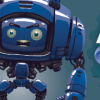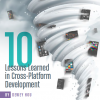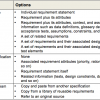 |
How the Right Business Engagement Can Lead to Transformation “Happy Ever After” Winning the hearts and minds of users should be a priority of business transformation from day one. This way the people who really know the day-to-day running of the business have the opportunity to ensure that the new system will meet their and the organization’s requirements when it’s delivered.
|
|
 |
Business and Development: Working Together to Build Better Products Business stakeholders and DevOps teams both have to take an active approach to app development, but neither faction should have to change practices and processes in order to get their needs across. Investing the time to establish communication between these teams will drive delivery of the applications customers demand.
|
|
 |
ADC West 2015 Keynote: Lean UX: Turn User Experience Design Inside Out When developing products, features, and enhancements, you have to have your customers’ best interests at heart. “We’re not just creating software,” speaker Jeff Patton said. “We’re changing the world.” You need to better understand the people you’re building things for, and the only way to do that is to spend more time with them.
|
|
 |
Establishing IT Controls for Consistent, Efficient Delivery Many high-security institutions have guidelines that must be followed in order to comply with industry regulatory requirements. But these best practices can help any company avoid costly mistakes while enabling teams to work faster and more effectively. This article tells you how to get started establishing your own practical and reliable IT controls.
|
|
 |
10 Lessons Learned in Cross-Platform Development Building an app for a single platform is difficult, but designing, implementing, and testing an app targeting multiple operating system platforms can be next to impossible. The secret balances upfront design with customer feedback.
|
|
 |
Requirements Reuse: Fantasy or Feasible? Software development teams think nothing about reusing code, but what about requirements? The benefits include faster delivery, lower development costs, consistency across and within applications, fewer defects, and reduced rework.
|
|
|
|
Lessons Learned from Ancient Wisdom: A Software Review Story Lessons learned long ago from reviews and inspection can be effective today, particularly in collaboration within agile teams. Learn how an organization used review techniques as part of its agile collaboration, including the advantages and potential problems of this ancient wisdom.
|
|
|
|
Simplicity and Precision: Test Planning in Agile Projects Test planning is often thought unnecessary in an agile project. However, if our mindset is on "planning" rather than "plans," we see that test-planning activities happen throughout the project, taking advantage of levels of precision, i.e., what is absolutely necessary at each level.
|
|
|
|
Traceability's Priceless Role in Agile: An Interview with William Gens William Gens sits down with Noel Wurst to describe "the art and science of traceability" ahead of his STAREAST session of the same name. Learn what makes traceability meaningful and such a valuable asset to projects, no matter how bad the requirements may seem to be.
|
|
|
|
Disciplined Agile Delivery: An Interview with Scott Ambler Scott Ambler is chief methodologist for IT with IBM Rational. Heather Shanholtzer recently had the opportunity to talk to Scott about scaling agile for enterprise organizations, how agile affects leadership and requirements on large teams, and his Disciplined Agile Delivery framework.
|
|
 |
How to Ensure That Requirements Are Testable
Slideshow
Discover practical ways to plan and prepare for the work, to communicate with testers and analysts about what needs to be done, and to create requirements that are understandable to everyone.
|
Arnika Hryszko
|
 |
Managing BDD Automation Test Cases inside Test Management Systems
Slideshow
Behavior-driven development (BDD) has been around for a while and is here to stay. However, the added abstraction levels pose a technical problem for writing and managing tests. While BDD does a great job of marrying the nontechnical aspect of test writing to the technical flow of an application under test, keeping this information under source control becomes problematic. Frameworks such as JBehave, Cucumber, or Robot give subject matter experts that additional ability to write tests, but they are often restricted access from them; because people treat test cases as code, they get stored in source control repositories. Additionally, these given-when-then steps soon can grow to an extent where they are difficult to manage without an IDE, and nontechnical people lose interest. Using management tools, Max Saperstone shows how to manage these nontechnical steps and keep them in sync with the automaton in tools such as Git.
|
Max Saperstone
|
 |
Mission Critical Automation Testing
Slideshow
When critical subsystems fail, the resulting losses can be catastrophic. In the insurance industry, if premiums are miscalculated, defect costs can reach well over a million dollars. In this session, Mike Keith and Dom Nunley draw on their practical experience with insurance systems testing to provide an overview of combinatorial automation testing for high-risk backend system areas—i.e., features that absolutely must work correctly. They share a process for categorizing requirement risk levels to determine which requirements warrant combinatorial testing. Mike and Dom illustrate various combinatorial testing techniques such as N-FAT, N-Wise, and RANDOM, which can be used to automatically generate test cases. These methods are used to ensure coverage against risk while controlling the number of tests that run.
|
Mike Keith
|
 |
The Five Biggest Mistakes Your Team Is Making in Requirements Definition
Slideshow
Google pioneer Alberto Savoia offered this sage advice: Build the right "it" before you build It right. But few software companies take the time to define, much less build, the right "it." The problem starts with a poor requirements definition process. In this session, join Kathryn Campbell as she examines the five most common mistakes that software companies make during requirements definition—and how to avoid them. First Kathryn defines thinking too small as a huge problem and shows you how to broaden your perspectives. Next, she exposes being stuck in the past, with legacy systems maintaining too much control of our innovation. The third mistake is assuming too much about your customers. Kathryn shares guerrilla techniques for gathering rapid, inexpensive customer feedback at every stage of your requirements and design process.
|
Kathryn Campbell
|
Visit Our Other Communities
CMCrossroads is a TechWell community.
Through conferences, training, consulting, and online resources, TechWell helps you develop and deliver great software every day.




















